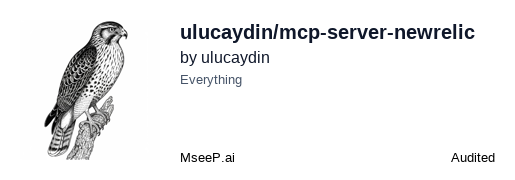About
This server exposes the New Relic NerdGraph API through Model Context Protocol, enabling clients like Claude Desktop to query account details, run NRQL and NerdGraph queries, manage entities, APM apps, Synthetics monitors, and alerts using natural language or commands.
Capabilities

Overview
The New Relic NerdGraph MCP Server bridges the gap between AI assistants and the rich telemetry ecosystem of New Relic. By exposing the NerdGraph API through the Model Context Protocol, it lets developers and data scientists query, manipulate, and visualize application performance metrics directly from conversational agents such as Claude Desktop. This eliminates the need to write custom API wrappers or manually copy and paste GraphQL queries, enabling rapid prototyping of monitoring dashboards, alert‑management workflows, and incident‑response playbooks within a single chat interface.
At its core, the server translates natural language or structured commands into NerdGraph GraphQL operations. It offers a curated set of tools—ranging from simple account‑level lookups to complex NRQL analytics—and resources that represent specific New Relic entities. Developers can ask the AI to “list all APM applications,” “run an NRQL query for error rates over the past week,” or “acknowledge a specific incident.” The server then handles authentication, query construction, and result formatting before returning the data back to the assistant for presentation.
Key capabilities include:
- Account Insights – Retrieve basic account metadata such as name, region, and feature flags.
- Generic NerdGraph Access – Execute arbitrary GraphQL queries, giving full flexibility for advanced use cases.
- NRQL Execution – Run NRQL statements against the account’s event data, ideal for ad‑hoc analytics.
- Entity Management – Search and fetch detailed information on applications, hosts, monitors, and other entities by GUID.
- APM & Synthetics – List APM services, discover synthetic monitors, and create simple browser tests.
- Alert Handling – Enumerate alert policies, view open incidents, and acknowledge or resolve them programmatically.
In real‑world scenarios this server powers a variety of AI‑driven workflows: an incident response bot that automatically pulls the latest error metrics when a new alert fires, a developer assistant that generates synthetic monitor templates on demand, or a data‑science notebook where analysts can query historical performance with plain language. By integrating seamlessly into existing MCP clients, the server removes friction from data access and lets teams focus on insight rather than boilerplate code.
Related Servers
Netdata
Real‑time infrastructure monitoring for every metric, every second.
Awesome MCP Servers
Curated list of production-ready Model Context Protocol servers
JumpServer
Browser‑based, open‑source privileged access management
OpenTofu
Infrastructure as Code for secure, efficient cloud management
FastAPI-MCP
Expose FastAPI endpoints as MCP tools with built‑in auth
Pipedream MCP Server
Event‑driven integration platform for developers
Weekly Views
Server Health
Information
Explore More Servers
ImageSorcery MCP
Local AI-powered image editing and recognition
Saqr-MCP
AI Assistant Server with Local and Cloud Model Support
Notetaker MCP Server
Seamless note management for Claude desktop
Secureframe MCP Server
Read‑only access to Secureframe compliance data for AI assistants
OpenAPI MCP Server
Expose OpenAPI endpoints as MCP resources for LLMs
MCP Test Openshift Server
Testing MCP on Red Hat OpenShift for continuous integration